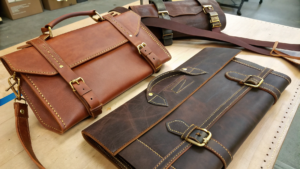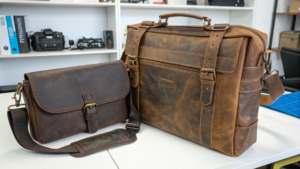What Material Is Best for Canvas Bag Handles?
Are you overlooking a key part of your canvas bag's design? I know many do. The handle is not just a strap; it is where comfort meets true brand integrity.
The best material for canvas bag handles balances comfort, durability, and a brand's specific values, with common options including cotton webbing, jute, leather, and reinforced synthetic blends, each offering distinct benefits for how the bag feels and performs.
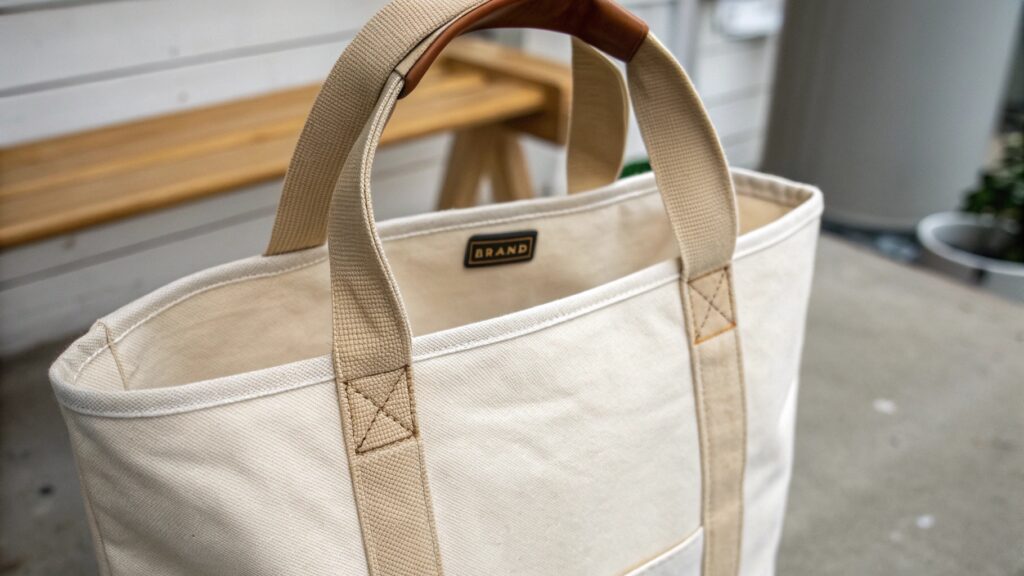
I have seen firsthand how much attention goes into the body of a canvas bag. People focus on its eco-friendliness, how it can be custom printed, and its overall toughness. But as someone who has worked in printing and gifting for years, I can tell you this: the handle is just as important. The material used for the handle affects how the bag feels in your hand. It also sends a clear message about how a brand balances comfort, sustainability, and how long the bag will last. It is a small detail that tells a big story about how much thought went into the product.
What Material Is Used for Bag Handles?
Have you ever wondered what goes into making a bag handle sturdy and comfortable? It is a common thought when you are looking for quality.
Bag handles use a variety of materials, including strong fabrics like cotton webbing1, natural fibers such as jute2 or hemp, durable options like leather, and various synthetic blends, each chosen for specific reasons like comfort, strength, or cost.
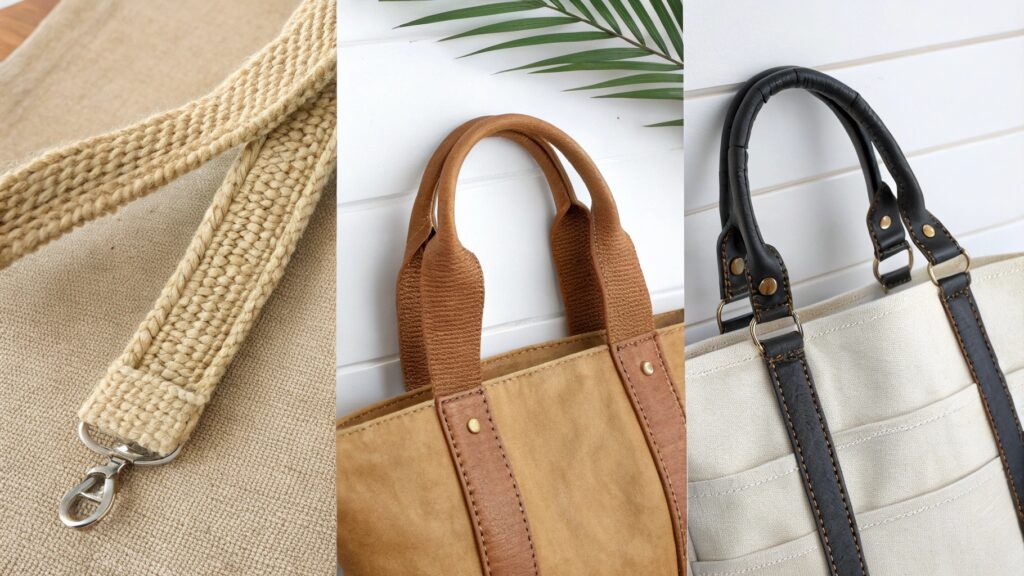
When it comes to bag handles, the choice of material is key. I have dealt with countless types in my career. Each material has its own benefits and drawbacks. Cotton webbing is a very popular choice. It is soft and comfortable to hold. It is also good for the environment because it is a natural fiber. You can find it in many widths and thicknesses. This makes it versatile. Jute and hemp are other natural options. They give a rustic look and are also eco-friendly. They are strong but can feel a bit rougher. Leather is used for higher-end bags. It adds a touch of class and is very durable. But it is not always a vegan choice, which matters to some customers. Then there are synthetic blends. These might include nylon or polyester. They are very strong and water-resistant. They are often used for heavier bags. They might not feel as "natural" but offer great performance. The choice really depends on the bag's purpose. It also depends on the brand's message. A brand might choose cotton for an eco-friendly tote. They might choose leather for a premium shopper.
Exploring Common Bag Handle Materials
The material of a bag handle is not just about looks; it is about performance. I have learned this from many years of working with different products. For example, cotton webbing is common for many reasons. It is gentle on the hands and shoulder. It breathes well. It is also easy to print on. This helps with branding. Jute handles give a very natural, earthy feel. They are strong, but they can be a bit coarse. I have seen them used a lot for promotional bags in organic markets. Leather handles offer top-tier durability and a luxurious feel. They age well, developing a unique look over time. However, they cost more and require different care. Polyester or nylon handles are tough. They resist wear and tear. They are often used for bags that need to carry heavy loads or be exposed to the elements. These materials are also good if you need to keep costs lower. Each choice reflects a specific design and budget goal. The right handle makes a bag much more functional and appealing.
| Handle Material | Key Characteristics | Pros | Cons | Ideal Use Case |
|---|---|---|---|---|
| Cotton Webbing | Soft, flexible, natural fiber, various widths. | Comfortable, eco-friendly, customizable. | Can absorb water, may fray over time. | Everyday tote bags, promotional items. |
| Jute/Hemp | Rustic, strong, coarse texture, natural fiber. | Very eco-friendly, unique aesthetic. | Less soft, can be rough on hands with heavy loads. | Organic market bags, artisanal products. |
| Leather | Durable, ages well, premium look, varying finishes. | High strength, luxurious feel, long-lasting. | Higher cost, not vegan, requires care, heavier. | High-end retail bags, fashion accessories. |
| Nylon/Polyester | Strong, lightweight, water-resistant, often smooth. | Excellent durability, good for heavy loads. | Less eco-friendly, can feel less natural. | Utility bags, outdoor gear, heavy-duty totes. |
| Rope | Flexible, nautical look, can be cotton or synthetic. | Comfortable (if thick), unique appearance. | Can unravel, less load distribution, may dig in. | Beach bags, casual totes. |
What Are Paper Bag Handles Made Of?
Have you ever thought about the handles on your paper bags? They seem simple, but their material is chosen for a reason.
Paper bag handles are commonly made from twisted paper, flat paper strips, or sometimes cotton or polyester cords. These materials are chosen for their strength, cost-effectiveness, and ability to be recycled with the bag.
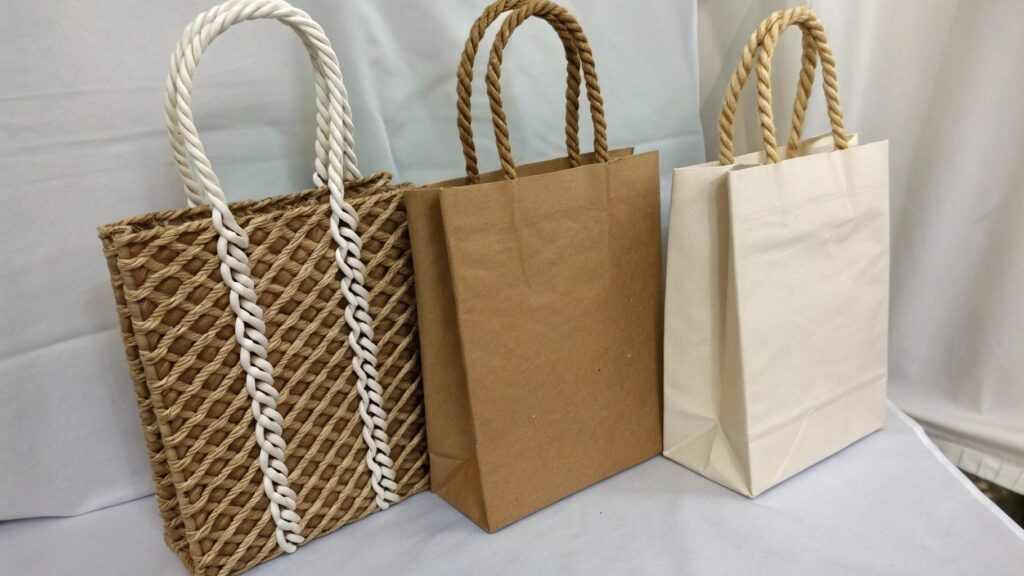
Paper bag handles might seem basic, but their design is clever. I have seen them made in many ways. The most common type is twisted paper. These handles are made from rolls of paper that are twisted tightly. This twisting makes them surprisingly strong. They are often glued inside the bag's top edge. Another common type is flat paper strips. These are just flat pieces of paper folded and glued down. They are often seen on smaller gift bags or lunch bags. Both twisted and flat paper handles are great because they are made of paper. This means the whole bag, handle and all, can often be recycled together. This makes them a very eco-friendly choice. For stronger paper bags, or those meant for heavier items, you sometimes see cotton or polyester cords. These are threaded through holes in the bag. They make the bag much stronger. These cords can be natural or synthetic. They add durability. But they might need to be removed before recycling the paper bag. The choice of handle for a paper bag depends on how much weight it needs to hold and how eco-friendly the brand wants to be. It is all about balance.
What Is the Material of Bag Straps?
Are you wondering about the materials used for longer, more robust bag straps? It is important for bags you carry over your shoulder.
Bag straps, especially for shoulder or crossbody bags, are often made from durable materials like nylon webbing, cotton webbing, polyester, genuine leather, or synthetic leather3, chosen for strength, comfort, and desired aesthetic.
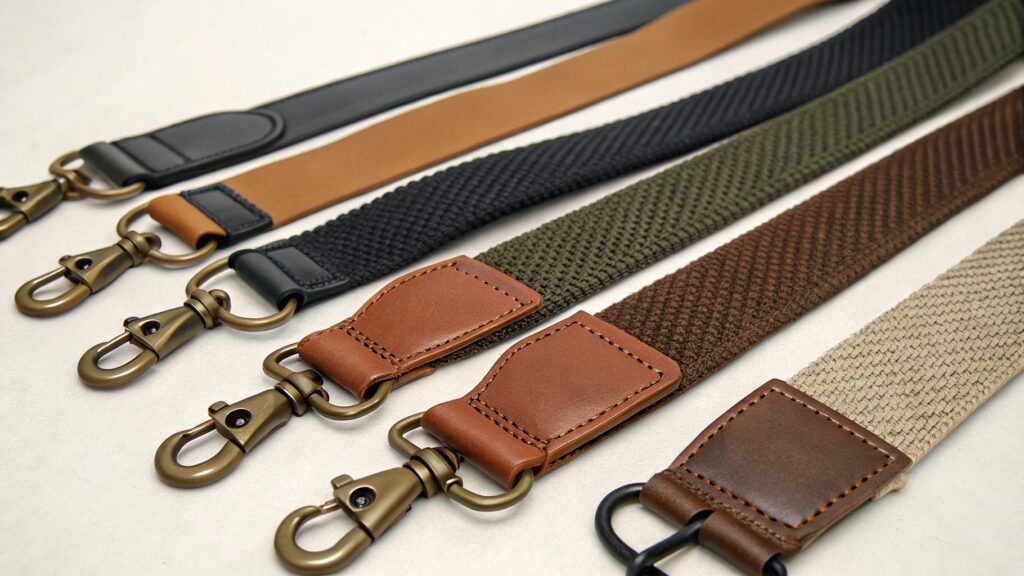
When we talk about bag straps, we are often thinking about longer straps. These are for shoulder bags, messenger bags, or backpacks. The materials for these are chosen for high durability and comfort. Nylon webbing and polyester webbing are very common. They are extremely strong. They resist water and abrasion. This makes them perfect for bags that see heavy use. Think about backpack straps or camera bag straps. They are often made from these synthetics. Cotton webbing is also used. It is softer and more breathable. It is a good choice for casual bags or eco-friendly options. I have personally used cotton webbing for promotional tote bags. They offer a good feel and can be dyed easily. Genuine leather is a classic choice for high-end bags. It is very durable and ages beautifully. Leather straps add a touch of luxury. However, they cost more and are not suitable for vegans. Synthetic leather is a good alternative. It looks like real leather but is more affordable and animal-friendly. It is important to pick the right strap material. A good strap makes a bag comfortable to carry, even when it is full. This is key for user satisfaction.
Conclusion
The handle or strap of a canvas bag is crucial. Its material choice—from cotton to leather—defines comfort, durability, and a brand's commitment to quality and values.
-
Explore the advantages of cotton webbing, a popular choice for bag handles due to its comfort and eco-friendliness. ↩
-
Learn about jute's unique properties and why it's favored for eco-friendly and rustic bag designs. ↩
-
Discover the benefits of synthetic leather as a versatile and animal-friendly alternative for bag straps. ↩



